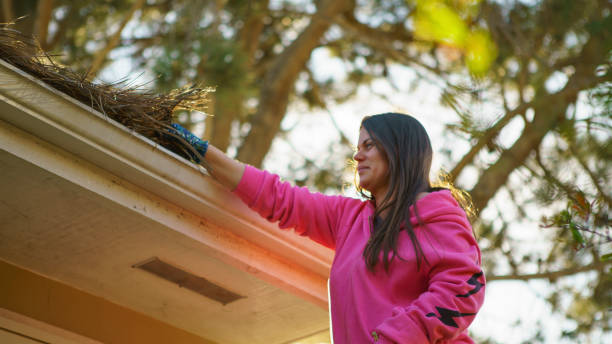The changing seasons in Fredericksburg, VA bring unique challenges to your home’s roof and gutter systems. From the hot, humid summers to the icy winters, every season has its impact, and if these changes aren’t properly addressed, they can lead to damage and costly repairs. Understanding how the seasons affect your gutters and roof will help you maintain these crucial systems year-round, ensuring your home stays protected.
Spring: Rain and Debris Accumulation
Spring is known for its rainy weather, which, while beneficial for plant growth, can put a strain on your gutters and roof. In Fredericksburg, VA, spring showers can lead to:
- Clogged Gutters: As trees begin to bud and flowers bloom, your gutters can quickly fill with leaves, twigs, and blossoms. Clogged gutters prevent water from flowing freely, potentially causing water to back up into your roof and walls, leading to water damage and even mold growth.
- Roof Leaks: Spring rains, combined with melting snow from the winter, can expose weak areas on your roof. If shingles were already compromised in winter, leaks could develop, leading to water entering your attic or walls.
- Increased Risk of Mold and Algae: Humid spring weather can lead to mold and algae growth on your roof and in your gutters, particularly in shaded areas. This growth can erode roofing materials, leading to premature wear and a shorter roof lifespan.
Spring Maintenance Tip: Clean out your gutters regularly to prevent debris buildup, inspect your roof for any leaks or damage, and ensure that your gutters are properly directing water away from your home.
Summer: Heat, Humidity, and Storms
Fredericksburg, VA summers bring high temperatures and frequent thunderstorms, both of which can impact your roof and gutters:
- Expansion and Contraction: The heat of summer can cause roofing materials, such as shingles, to expand. Over time, the expansion and contraction due to fluctuating temperatures can lead to cracks or gaps in your roof, allowing water to seep in.
- Storm Damage: Summer thunderstorms often bring heavy rain, high winds, and hail, all of which can damage your roof. High winds may loosen shingles, while hail can create dents and punctures, compromising your roof’s ability to protect your home. Clogged gutters from falling debris can also exacerbate storm damage by preventing proper drainage.
- Heat-Related Wear on Roof Materials: Extended exposure to the intense summer sun can cause certain roofing materials, like asphalt shingles, to become brittle and degrade. Over time, this can lead to cracks and leaks, reducing the lifespan of your roof.
Summer Maintenance Tip: Have a roofing professional inspect your roof for any damage after storms, check for loose or damaged shingles, and ensure gutters are free of debris. Consider applying a protective coating to extend the lifespan of your roof.
Fall: Leaves, Debris, and the Risk of Ice Dams
As the leaves begin to change color and fall, the autumn season in Fredericksburg, VA can cause significant stress on your roof and gutters:
- Leaves and Debris Buildup: Falling leaves are one of the biggest culprits of clogged gutters in the fall. As gutters become packed with leaves, they can’t effectively channel water away from your home, which can result in water damage, especially around the foundation and roofline.
- Increased Risk of Ice Dams: As temperatures begin to drop, any standing water in your gutters can freeze. If water backs up and freezes under your shingles, it can lead to the formation of ice dams. Ice dams prevent water from draining properly and can cause leaks, water damage to the interior of your home, and even roof structural damage.
- Roof Shingle Damage: Wind, rain, and debris can cause wear on shingles, leading to cracks or breaks in the roofing material. These small issues can grow more significant over the winter months, as water can seep in and freeze.
Fall Maintenance Tip: Clean your gutters thoroughly to remove leaves and other debris, check for loose or damaged shingles, and ensure proper drainage to prevent the formation of ice dams in the winter.
Winter: Cold Temperatures and Ice Dams
Winter in Fredericksburg, VA can be harsh, and freezing temperatures bring several challenges for your roof and gutters:
- Ice Dams: As mentioned above, ice dams are a common problem in winter. When snow on your roof melts due to heat loss from the attic, the water can freeze in your gutters, creating an ice dam. This buildup of ice prevents water from flowing freely, causing it to back up onto the roof and leak into your home. Ice dams can lead to severe damage to roofing materials and the structure of your home.
- Snow and Ice Weight: Heavy snow and ice accumulation on your roof can strain the roofing structure, especially if the snow isn’t removed in time. The weight of the snow and ice can cause roof sagging or even collapse in extreme cases.
- Gutter Freezing: In the winter, standing water in your gutters can freeze, preventing proper drainage and causing gutters to pull away from the house due to the weight of the ice. This can lead to gutter damage or detachment, leaving your home vulnerable to water damage when the ice melts.
Winter Maintenance Tip: Keep gutters clean to prevent standing water from freezing, ensure your roof is insulated and ventilated to prevent ice dams, and remove snow buildup as soon as possible. If ice dams do form, consider professional removal.
Year-Round Roof and Gutter Maintenance
To ensure your roof and gutters can handle the demands of each season, regular maintenance is key:
- Inspect Your Roof and Gutters at Least Twice a Year: Conduct roof and gutter inspections in the spring and fall to check for any issues that could be exacerbated by seasonal changes.
- Clean Your Gutters Regularly: This helps prevent debris buildup and ensures proper drainage year-round.
- Trim Trees Around Your Roof: Overhanging branches can cause damage to your roof in any season, particularly in windstorms and heavy snowfall.
- Repair Leaks and Damage Promptly: Small issues left unchecked can grow into more significant problems, especially with the change in weather conditions.
Trusted Roofing and Gutter Service Company Serving Fredericksburg, VA, and Surrounding Areas
Each season in Fredericksburg, VA presents unique challenges for your roof and gutters, but with regular maintenance and timely repairs, you can protect your home from seasonal damage. By staying proactive and addressing potential issues before they worsen, you can extend the lifespan of your roof and gutters, prevent costly repairs, and ensure your home stays safe and dry all year round. If you’re unsure about the condition of your roof or gutters, consider consulting with a professional to keep your home protected through every season.
If you’re ready to take the stress out of gutter maintenance, contact us today. Let us show you why we’re the best in the business!

